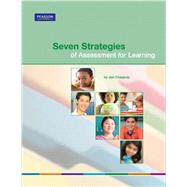
Note: Supplemental materials are not guaranteed with Rental or Used book purchases.
Purchase Benefits
What is included with this book?
Prior to joining ATI, Jan Chappuis was a curriculum and assessment specialist responsible for professional development and school improvement. Her background as an elementary and secondary teacher, combined with her assessment expertise and professional development experience, enables Jan to provide teachers and school leaders with practical solutions for motivating students and involving them in their own academic success. Her most recent publication, Seven Strategies of Assessment for Learning, helps teachers adopt formative assessment practices shown to improve learning.
CHAPTER 1: Formative Assessment and Assessment for Learning........................................1
What Is Formative Assessment?..............................................................................................................4
Summative Assessment.....................................................................................................................5
Formative or Summative?.................................................................................................................6
What Gives Formative Assessment Its Power?......................................................................................7
Formative Assessment in Teachers’ Hands......................................................................................9
Formative Assessment in Students’ Hands....................................................................................10
Seven Strategies of Assessment for Learning......................................................................................11
Where Am I Going?.........................................................................................................................11
Where Am I Now?...........................................................................................................................12
How Can I Close the Gap?...............................................................................................................13
Conclusion ............................................................................................................................................14
The Chapters Ahead.............................................................................................................................14
CHAPTER 2: Where Am I Going? Clear Targets.......................................................................15
Strategy 1: Provide students with a clear and understandable vision of the learning target............22
Converting Knowledge and Reasoning Learning Targets to
Student-friendly Language....................................................................................................................22
Defining Quality for Reasoning, Performance Skill, and Product Learning Targets....................28
When to Share the Learning Target................................................................................................41
Checking for Understanding of the Intended Learning.................................................................41
Strategy 2: Use examples and models of strong and weak work.........................................................42
Knowledge and Reasoning Learning Targets: Selected Response Items......................................42
Reasoning, Performance Skill, and Product Learning Targets:
Performance Assessment Methodology..........................................................................................43
Examples of Strategies 1 and 2 with Elementary Students.................................................................46
Inference Scenario..........................................................................................................................47
Conclusion.............................................................................................................................................51
CHAPTER 3: Where Am I Now? Effective Feedback .............................................................53
Characteristics of Effective Feedback .................................................................................................56
1. Effective feedback directs attention to the intended learning.................................................57
2. Effective feedback occurs during learning.................................................................................68
Other Feedback Variables to Consider.................................................................................................69
3. Effective feedback addresses partial understanding.................................................................70
4. Effective feedback does not do the thinking for the student....................................................72
5. Effective feedback limits correctives to what students can act on...........................................74
Suggestions for Offering Feedback.......................................................................................................75
Picture or Symbol Cues...................................................................................................................75
Assessment Dialogues.....................................................................................................................78
Peer Feedback.......................................................................................................................................83
Scaffolding a Peer Feedback Conference.......................................................................................84
Peer Response Groups....................................................................................................................87
Conclusion.............................................................................................................................................92
CHAPTER 4: Where Am I Now? Self-assessment and Goal Setting......................................93
Impact of Self-assessment on Student Achievement...........................................................................96
Three Parts: Self-assessment, Justification, and Goal Setting.............................................................99
Quick Self-assessment Ideas.................................................................................................................99
Self-assessment and Goal Setting with Selected Response and
Constructed Response Tasks...............................................................................................................103
Before: Targeting the Learning.....................................................................................................103
During: Self-assessment While Completing an Assignment, Quiz, or Test ...............................109
After: Self-assessment and Goal Setting Using the Results of a Formative Quiz or Test..........111
Self-assessment and Goal Setting with Performance Assessment Rubrics......................................117
Prerequisites.................................................................................................................................117
Ways to Format Rubric Text.........................................................................................................118
Using the Rubric Itself...................................................................................................................119
Goal Setting.........................................................................................................................................123
Helping Students Set Specific, Challenging Goals.......................................................................124
The Goal-setting Conference........................................................................................................126
Conclusion...........................................................................................................................................127
CHAPTER 5: How Can I Close the Gap? Focused Teaching and Revision.........................129
Scaffolding with Selected Response and Short Constructed Response Items.................................132
Identifying and Using Typical Misconceptions and Reasoning Errors .......................................132
Multiple-choice Items as Teaching Tools......................................................................................134
Using Graphic Organizers as Teaching Tools...............................................................................139
Scaffolding with Performance Assessment Tasks and Rubrics.........................................................141
Creating Focused Tasks.................................................................................................................141
Practicing One Criterion at a Time...............................................................................................145
Conclusion ..........................................................................................................................................146
CHAPTER 6: How Can I Close the Gap? Tracking, Reflecting On, and
Sharing Learning........................................................................................................................149
Students Keeping Track of Their Learning........................................................................................152
Recording Progress.......................................................................................................................152
Keeping Learning Journals............................................................................................................153
Collecting Samples of Work...........................................................................................................156
Students Reflecting on Their Learning...............................................................................................159
Reflecting on Growth.....................................................................................................................159
Reflecting on a Project..................................................................................................................162
Reflecting on Achievement...........................................................................................................164
Students Reflecting on Themselves as Learners..........................................................................165
Students Sharing Their Learning .......................................................................................................167
Writing to Others..........................................................................................................................167
Participating in Conferences.........................................................................................................169
Conclusion ..........................................................................................................................................174
Closing Thoughts................................................................................................................................174
Appendix A: Student-friendly Scoring Rubrics......................................................................175
Appendix B: Reproducible Forms...........................................................................................199
Bibliography ...............................................................................................................................255
The New copy of this book will include any supplemental materials advertised. Please check the title of the book to determine if it should include any access cards, study guides, lab manuals, CDs, etc.
The Used, Rental and eBook copies of this book are not guaranteed to include any supplemental materials. Typically, only the book itself is included. This is true even if the title states it includes any access cards, study guides, lab manuals, CDs, etc.